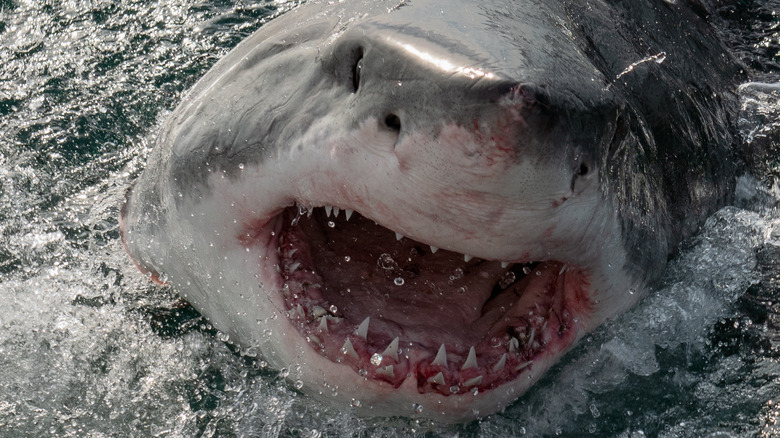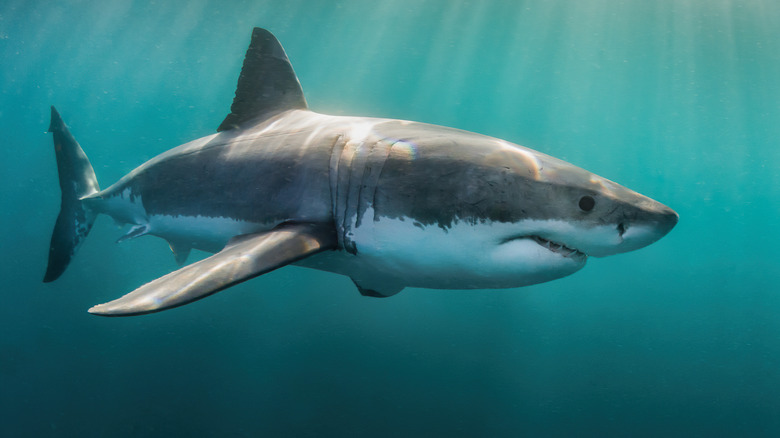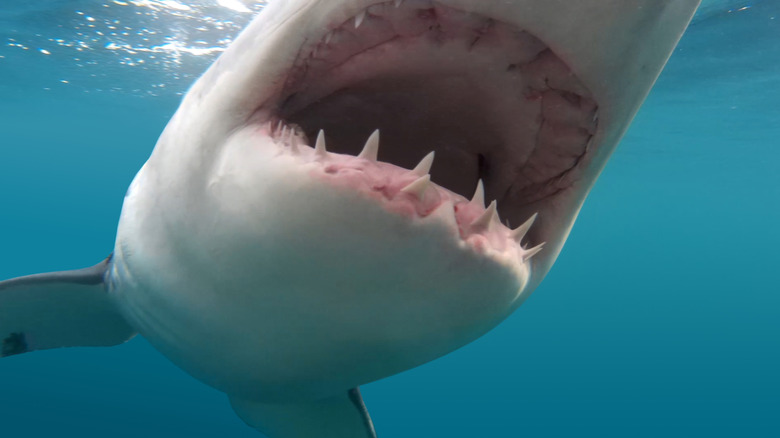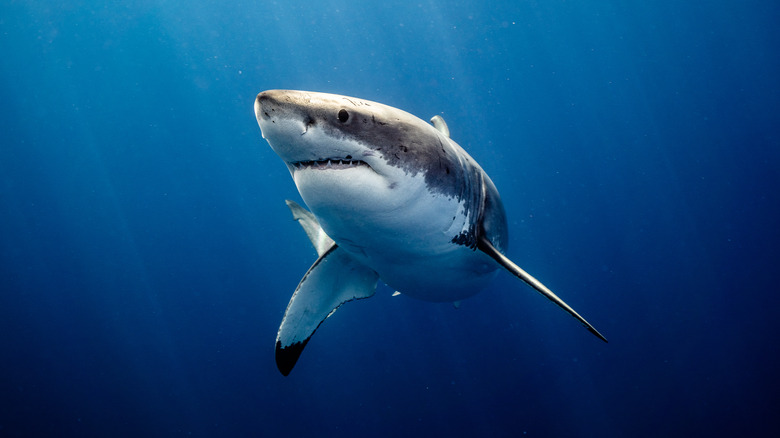This Is Why You'll Probably Never See A Great White Shark At An Aquarium
You're planning that memory-making family road trip and in the midst of binge-watching "Sharknado" volumes 1 – 6, or the popular "Shark Week" on Discovery, when the brilliant thought occurs to you: Syfy channel originals and nature documentaries are all very well and good, but wouldn't the kids get a kick out of seeing a real great white shark live and in person — or well, behind plexiglass, of course, or whatever it is aquariums use to keep them there and us over here? The only problem with that plan is that as of this report, there are no great white sharks to see in an aquarium anywhere, and for good reason.
Don't despair, though, there are lots of species of sharks out there — according to the Smithsonian. There are more than 500 known shark species in fact, and many are available for your family to visit at an aquarium while on your road trip, as Drive the Nation notes. While the great white shark gets most of the archetype business, it's not even the fastest; that's the mako, known to hit speeds of up to 35 miles an hour, says National Geographic. But ever since Peter Benchley sold a whole bunch of copies of the book "Jaws" back in 1974, coupled with the resulting movie franchise — for many people, when they think of a shark, they picture the menacing great white, and they won't be satisfied with anything less.
The great white shark: an aquatic celebrity
As of this report, the fact that there are no great white available for viewing in an aquarium is not for lack of trying. Efforts to open a great white shark attraction surged in the '70s, around the same time that the movie "Jaws" came out, though none were successful, based on a report from The Jakarta Press. Since then, there have been many attempts to keep great white sharks in captivity, dating as far back as the '50s, with some lasting less than a day before the creature died, as Vice reports. A small great white managed to survive for about six months at The Monterey Bay Aquarium but was finally released into the wild after it started eating other sharks — as sharks will do. In 2016, a nearly 12-foot great white died in Japan after only three days in an aquarium, as Vice goes on to explain.
The man largely behind the great white-mania was Peter Benchley, whose 1974 bestselling novel "Jaws" about a great white noshing on people sold something like 10 million copies and was later adapted into the hit film of the same name directed by Steven Spielberg. Despite the success, Benchley regretted writing the book. In 2015 The Boston Globe quoted him this way: "What I now know, which wasn't known when I wrote 'Jaws,' is that there is no such thing as a rogue shark which develops a taste for human flesh. No one appreciates how vulnerable they are to destruction."
Great whites are big eaters
Interest in seeing a great white up close and personal is about more than just hype, though. Great whites are indeed among the most impressive creatures on the planet. They hit maximum growth at around age 9 or 10, reaching lengths of up to 20 feet and sometimes weigh more than three tons. If that's not scary enough, they can sometimes be equipped with 50-ish teeth of lengths of up to six inches, as Oceana USA tells us.
The great white gill structure also means they have to move in order to draw water across their gills to obtain oxygen, which helps explain their need to keep swimming nonstop, per IFL Science. Great whites are otherwise nomadic predators: The bigger they are, the farther they roam, and the bigger the prey they need to consume. Despite how they're portrayed in popular culture, great white shark attacks on humans are really quite rare, as Petpedia explains. It's in this prodigious appetite, though, where the primary challenge with keeping great whites behind glass partially comes into focus.
Great whites need a lot of space
Great whites aren't just eating machines, either. The great white sharks' need for territory — sort of like "swim free or die trying" — often leads the sharks to injure themselves while in captivity as they bump up against the sides of their salt water pens, as Science Alert explains. For this reason, great whites are easily stressed while in captivity. Feeding them also becomes a problem — the larger the shark, the more complicated its dietary requirements.
When they're small, great whites are satisfied with smaller fish (or even smaller sharks) but eventually, they grow to consume mammals, like seals. (Well, yes, sometimes people, too, but as previously mentioned, that's rare, and far more people kill sharks than the other way around, as Reader's Digest points out.) When stressed, great whites sometimes stop eating entirely. So, with no great whites in captivity at the time of this writing, is there really no way to see one for yourself? Only by scuba diving in a cage, per Bluewater Travel.



